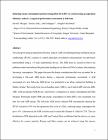| dc.contributor.author | Mc Nabola, Aonghus | en |
| dc.contributor.author | Gallagher, John | en |
| dc.date.accessioned | 2020-01-17T15:07:52Z | |
| dc.date.available | 2020-01-17T15:07:52Z | |
| dc.date.issued | 2017 | en |
| dc.date.submitted | 2017 | en |
| dc.identifier.citation | Morgan, D., Gallagher, J., Daly, T., McNabola, A, Reducing energy consumption and increasing filter life in HVAC systems using an aspiration efficiency reducer: Long-term performance assessment at full-scale, Journal of Building Engineering, 12, 2017, 267 - 274 | en |
| dc.identifier.other | Y | en |
| dc.identifier.uri | https://www.sciencedirect.com/science/article/pii/S235271021730195X | |
| dc.identifier.uri | http://hdl.handle.net/2262/91344 | |
| dc.description | PUBLISHED | en |
| dc.description.abstract | The concept of using an aspiration efficiency reducer (AER) in building heating ventilation and air conditioning (HVAC) systems to control particulate air pollution concentrations was previously demonstrated using a 1:4 scale experimental device. The AER acted as a passive form of air pollution control and reduced the particulate loading rate on filters in HVAC systems, thus reducing fan energy consumption. This paper discusses the design considerations that were accounted for in developing a full-scale AER device during a long-term performance assessment. A field assessment of a new full-scale AER device was performed at an urban commercial building in Dublin, Ireland. The results from two air handling units (AHUs), one Control-AHU and one AER-AHU (with an attached AER device), allowed for a comparison of energy consumption and filter lifespans. Particulate matter (PM) and energy consumption in both AHUs were monitored over time for each AER design. The full-scale AER device reduced PM concentration entering the HVAC system by 34% over the operational life cycle of a filter, reducing energy consumption by up to 14%. Alternatively the AER could be used to extend the lifespan of a filter by 75%. The size distribution of PM deposited on the AER and Control filters established that the device was more effective for coarser particles. Energy and filter savings can be achieved using this passive technique, which can translate to environmental, resource and economic savings in the building HVAC sector. | en |
| dc.format.extent | 267 | en |
| dc.format.extent | 274 | en |
| dc.language.iso | en | en |
| dc.relation.ispartofseries | Journal of Building Engineering | en |
| dc.relation.ispartofseries | 12 | en |
| dc.rights | Y | en |
| dc.subject | Heating | en |
| dc.subject | Ventilation and air conditioning | en |
| dc.subject | Energy consumption | en |
| dc.subject | Filter life | en |
| dc.subject | Aspiration efficiency | en |
| dc.subject | Particulate matter | en |
| dc.subject | Pressure drop | en |
| dc.title | Reducing energy consumption and increasing filter life in HVAC systems using an aspiration efficiency reducer: Long-term performance assessment at full-scale | en |
| dc.type | Journal Article | en |
| dc.contributor.sponsor | Enterprise Ireland | en |
| dc.type.supercollection | scholarly_publications | en |
| dc.type.supercollection | refereed_publications | en |
| dc.identifier.peoplefinderurl | http://people.tcd.ie/amcnabo | en |
| dc.identifier.peoplefinderurl | http://people.tcd.ie/jgallag9 | en |
| dc.identifier.rssinternalid | 171277 | en |
| dc.identifier.doi | http://dx.doi.org/10.1016/j.jobe.2017.06.014 | en |
| dc.rights.ecaccessrights | openAccess | |
| dc.contributor.sponsorGrantNumber | EI-IP.2013.0279 | en |
| dc.relation.doi | 10.1016/j.jobe.2017.06.014 | en |
| dc.relation.cites | Cites | en |
| dc.subject.TCDTheme | Smart & Sustainable Planet | en |
| dc.subject.TCDTag | Air Pollution | en |
| dc.subject.TCDTag | Buildings, Commercial Energy Use | en |
| dc.subject.TCDTag | ENERGY EFFICIENCY | en |
| dc.subject.TCDTag | Heating/Ventilation/Air Conditioning | en |
| dc.identifier.orcid_id | 0000-0002-8715-1180 | en |
| dc.status.accessible | N | en |




